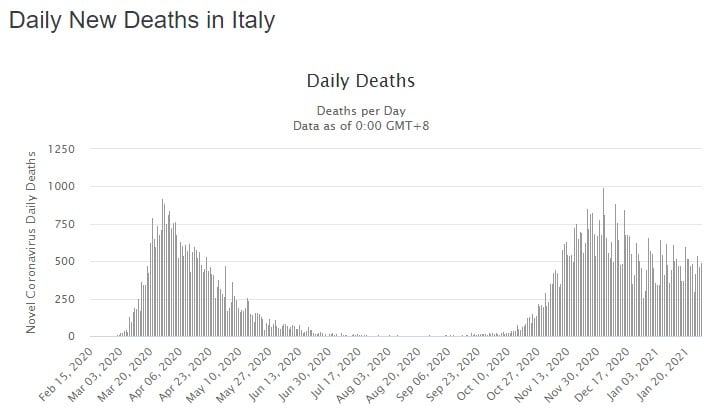Italy's coronavirus indicators appear to be plateauing this week, as government ministers debate the extent to which they should ease the current restrictions.
CHARTS: Where is the coronavirus spreading fastest in Italy?
But on Friday, media reports citing a dossier from Italy's intelligence agencies cast doubt on the accuracy of some official data.
According to La Repubblica, an intelligence dossier delivered to outgoing prime minister Giuseppe Conte stated that the daily tally of new positive cases has been underestimated by 40-50 percent.
“The total number of infected people is underestimated due to the drop in the number of tests which occurred in mid-November 2020”, the document reportedly stated.
The dossier also said current data was unreliable, meaning that the epidemiological curve may not be going down as much as Ministry of Health data shows.
Italy's Higher Health Institute (Istituto Superiore di Sanità, or ISS) did not rule out the possibility that the data may be wrong.
“This is possible. In surveillance systems there is often a share of the cases diagnosed and reported that can be underestimated,” Paola Stefanelli, director of the ISS Preventable Diseases Department, told Radio Anch'io on Friday.
What caused the problem?
The issue appears to stem from a change to the way the Health Ministry records coronavirus swab testing.
Authorities added rapid test results to the figures in mid-November 2020. Before that, only molecular swab tests were counted in the data.
This change, according to the intelligence dossier, created chaos.
“The introduction of rapid tests made it impossible to compare with past historical data,” it reportedly states.
“Some regions, moreover, do not distinguish between the molecular and the rapid tests, and this has obvious repercussions on the calculation of all values, including the positive ratio of tests carried out.”
The dossier argues that reporting methodology should be reviewed, separating the types of tests – not least because anyone who gets a positive result with a rapid antigen test must then have it confirmed with a molecular swab test, which are thought to be more reliable.
“It is only the first diagnosis swabs that give a picture the real epidemiological situation, and since mid-November we have seen a sharp decline in this type,” it stated.
Not all data are said to be affected.
The recorded number of deaths and ICU admittances are still believed to give an accurate picture of the situation in Italy.

Deaths recorded in Italy per day up to January 29th. Graph: Worldometers
What are the current figures?
The numbers of deaths and ICU admissions recorded, while fluctuating from day to day, do not appear to be dropping overall.
According to the Ministry of Health, the country on Friday recorded 477 new deaths, after 492 on Thursday, which fits into the broad range of a daily mortality rate of 300 to 600 recorded over the past three weeks.
This is in contrast to peaks in November and early December, when around 1,000 deaths were recorded on some days.
In its latest bulletin, the Ministry of Health said the latest data showed a per capita decrease in the infection rate.
The official data showed 14,372 new confimed cases on Friday.
It remains to be seen whether Italy's health authorities will update any data sets or take any other actions based on the dossier's findings.
Follow all The Local's coverage of the Covid-19 pandemic in Italy here.





 Please whitelist us to continue reading.
Please whitelist us to continue reading.
“number of deaths and ICU admittances are the only accurate data available.” These were always the only accurate data available, but also the only data that matters. Case number trends are only helpful for predicting deaths and ICU admittances.
If the actual number of cases has been higher than we thought, that’s good news. Those cases would have been low risk, healthy people who never needed medical attention, and their recovery will contribute to herd immunity and perhaps the death rate of COVID is not as high as we feared.
In view of this new information, what would the actual total deaths to date be and what are the daily contagion figures?
It seems to me that between announcing the correct numbers of infections and the availability of vaccines Tha Italy is doing a rather disappointing job of dealing with the pandemic.
And now, with this massive under-reporting of cases, the government is recklessly relaxing the rules just as the vaccination campaign begins, meaning that we will see a spike in cases in late February and a return to a lockdown in March. Madness! Keep the restrictions in place until the most vulnerable are vaccinated and THEN begin the easing. The restrictions on travel between regions cannot be lifted until we reach community immunity, presumably in the late summer.
It would be interesting to know the number of deaths or numbers in ICUs per 100,000 for each province ….Surely this would give a more accurate picture than positive test numbers – is this information available somewhere?
I have read this article several times. I don’t understand what the article is saying, or is the absence of a conclusion deliberate?